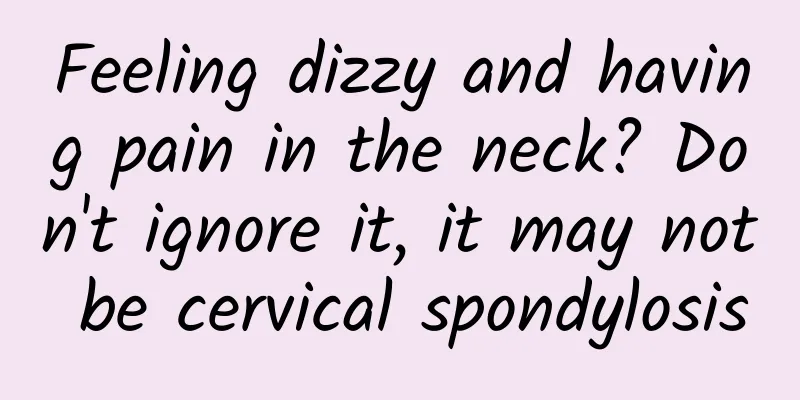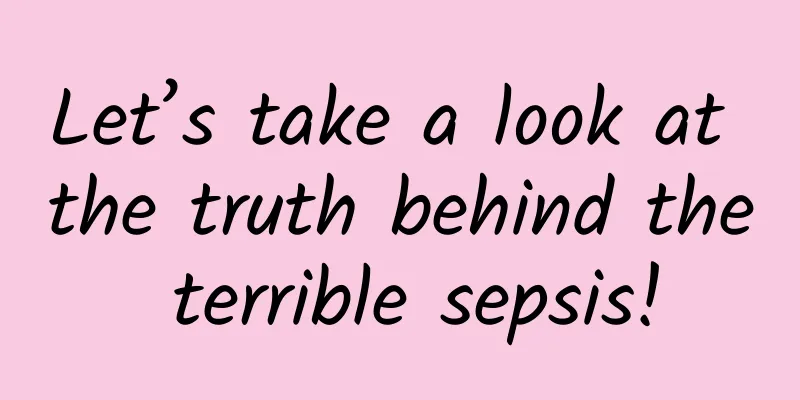Feeling dizzy and having pain in the neck? Don't ignore it, it may not be cervical spondylosis

|
Mr. Li is a 45-year-old senior corporate manager. He recently suffered from frequent retching, dizziness and cervical pain. He visited multiple departments in several hospitals, from neurology to orthopedics, but the results of various examinations showed no obvious abnormalities. At the doctor's suggestion, he went to the psychology department and was diagnosed with depression. This diagnosis surprised Mr. Li and his family, and Mr. Li himself didn't understand why physical discomfort was related to psychology. Why does depression produce somatic symptoms? The general perception of depression is that it has psychological and emotional impacts, but in fact, people with depression may experience various physical discomforts while experiencing psychological distress. Somatic symptoms refer to patients mapping their psychological distress onto their bodies, causing various physical discomforts and discomforts such as body pain and muscle tension, fatigue and decreased physical strength, nausea and vomiting, dizziness and headaches, palpitations and difficulty breathing, insomnia and sleep problems. There is no exact physiological cause for these discomforts in medicine. Image source: Photo Network The appearance of somatic symptoms is not a false appearance or a pretense of illness, but a natural response of the body to emotions and stress when the patient is experiencing psychological distress . Depression may affect neurotransmitters, hormone levels, and the immune system, leading to the appearance of somatic symptoms. Therefore, we often say that the somatic symptoms of depression are the physical expression of psychological distress. Different subtypes of depression have different clinical manifestations. For example, patients with mixed depression and anxiety disorder may have somatic symptoms such as retching, dizziness, and cervical pain. According to the 11th edition of the International Classification of Diseases (ICD-11), the subtypes of depression mainly include the following: Single episode depressive disorder : refers to a depressive episode in an individual without a previous depressive episode. The depressive episode lasts for at least two weeks and is characterized by depressed mood or decreased interest in activities almost every day, accompanied by other symptoms such as difficulty concentrating, feelings of worthlessness, excessive guilt, hopelessness, recurrent death or suicidal thoughts, changes in sleep or appetite, psychomotor agitation or retardation, decreased energy or fatigue, etc. Recurrent depressive disorder : refers to an individual having two or more depressive episodes with a gap of at least several months between each episode. Dysthymic disorder : manifested by a long-term depressed mood, but does not meet the diagnostic criteria for a depressive episode. Mixed depressive-anxiety disorder : The patient has both anxiety and depression, but neither meets the diagnostic criteria for anxiety-related disorders nor depressive episodes. Other specific depressive disorders : refers to those that do not meet the diagnostic criteria for any depressive disorder but have obvious typical symptoms of depression. Unspecified depressive disorder As for the "sunshine depression" that you often see on the Internet, it is not included in the diagnostic criteria of ICD-11 or DSM-5. " Sunshine depression " is also called "smiling mask syndrome" and "smiling depression". This concept was proposed by Professor Makoto Natsume of Shoin Women's University in Osaka, Japan. Patients with "sunshine depression" are not uncommon in life. They are often accustomed to hiding their inner emotions, so they are easily missed or misdiagnosed as physical diseases , and it is easy to miss the best time for treatment. Image source: Photo Network How to determine whether you have depression? Depression is a common mood disorder with significant and persistent low mood as the main clinical feature. The causes of depression are very complex and may include: biochemical factors (imbalance of neurotransmitters, such as serotonin, dopamine, norepinephrine, etc.), physical diseases (such as stroke, heart attack, cancer, etc.), genetic factors, psychosocial factors, gender differences (women are more susceptible to depression due to changes in hormone levels), drug abuse, etc. Self-diagnosis of depression can focus on the following aspects: Persistent low mood that is out of proportion to the situation, ranging from sullen to devastated Loss of interest and pleasure Fatigue, decreased energy or loss of energy Difficulty concentrating Reduced self-esteem and confidence Guilt and worthlessness Pessimistic future Self-harm or suicidal thoughts or behaviors Sleep disorders Decreased appetite Image source: Photo Network However, it should be noted that the diagnosis of depression is not simply made through scales or self-judgment. It requires a psychiatrist to make a comprehensive assessment and diagnosis based on clinical manifestations and authoritative diagnostic evidence . Taking the diagnostic criteria of the International Classification of Diseases, 11th edition (ICD-11) as an example, the diagnostic basis for depression is as follows. Required symptoms : The patient needs to have persistent low mood and/or loss of interest or pleasure for at least two weeks . Additional symptoms : Marked decrease in energy or vitality; negative self-image and thoughts of self-harm; being in states of extreme anger or irritability. Other symptoms : significant decrease in attention and concentration; extreme fatigue and decreased physical activity; significant sleep disturbances (such as difficulty falling asleep, early awakening, decreased sleep duration); decreased appetite; weight loss; flushing or sweating, etc. How to prevent and treat depression? There are many ways to prevent depression, and the easiest way to start is to adjust your lifestyle and your mind . In terms of life, pay attention to rest, avoid staying up late, get enough sleep, and do some physical exercise, such as jogging and yoga, which can help promote the body to secrete calming neurotransmitters and relieve emotions. In terms of psychology, you can talk appropriately, vent your emotions reasonably, and relieve stress through mindfulness, meditation, and other methods. Image source: Photo Network The treatment of depression can be roughly divided into psychotherapy, drug therapy and physical therapy. Psychotherapy : including cognitive behavioral therapy, psychoanalysis, humanistic therapy and other psychotherapy methods. The common goal of these methods is to help patients identify and transform negative thinking patterns , thereby improving their emotional state and behavioral responses and promoting mental health. Drug treatment : Antidepressants are one of the common choices for treating depression. There are many antidepressants available, such as paroxetine, sertraline, fluvoxamine, etc. Usually, doctors will choose the appropriate drug according to the patient's specific situation. Patients can use antidepressants for treatment under the guidance of a doctor. It should be noted that the taking cycle of antidepressants is relatively long. Patients should follow the doctor's advice to reduce or stop taking the medicine to avoid adjusting the dosage or stopping the medicine on their own, which may cause the disease to recur . Physical therapy : transcranial magnetic stimulation (TMS), electroconvulsive therapy (ECT), etc. Depression is a recurrent disease, and the goal of treatment is to relieve symptoms, improve quality of life, and prevent relapses. With proper treatment, most patients with depression can achieve long-term relief of symptoms, but a radical cure for depression requires the joint efforts of patients and doctors as well as long-term attention and management. Author: Zhao Yajuan, psychotherapist at Shanghai Mental Health Center Planning & Editing: Ding Dong |
>>: Liquid oxygen-kerosene rocket engine: the "new engine" supporting China's space program
Recommend
Will native applications be replaced by web applications and new browsers?
A common refrain about the future of mobile is th...
A boundless lake appears in the desert, and the spring breeze blows through Yumen Pass?
Produced by: Science Popularization China Author:...
Latest research: Will intermittent fasting cause baldness? Scientific maintenance methods revealed!
As a popular diet, intermittent fasting has attra...
Narrative Change Training Camp: From Passive to Active, Make Your Life More Controlled
Narrative Change Training Camp: From Passive to A...
How do we do code review?
A few days ago, I read "Code Review: The Hop...
Why is Android no longer suitable for the era of smart cars?
As more and more car companies begin to emphasize...
What is it like to have a "SPA" in a cabin at -180℃?
Amid the anticipation of the people across the co...
Higher Education Policy Institute & Kortext: AI usage among UK university students will reach 92% in 2025, and academic assessment usage will rise to 88%
According to the latest research, the use of gener...
If JAC Volkswagen’s first SUV is an iEV7S with a different shell, would you still buy it?
Ever since the establishment of the JAC Volkswage...
The cumulative number of confirmed cases of new coronary pneumonia in the world has exceeded 8 million, and the number in the United States has exceeded 2.11 million! How many people are there exactly?
Currently, the vaccine for the new coronavirus is...
Hulunbuir Mini Program Customization Company, how much does it cost to customize a tattoo mini program?
There are two types of customization for Hulunbui...
The second phase of the advanced watercolor illustration course of Yi Qiqi will end in June 2021 [good quality]
The second phase of the advanced watercolor illus...
On World Malaria Day, let’s review the development process of the antimalarial drug artemisinin
April 25th of each year is World Malaria Day, whi...
What will life be like for someone whose kidneys are broken?
In recent times, topics related to Thailand touri...
Wuwei SEO training: How to improve the weight of the website's internal pages
The most important thing for us to do website opt...









